Papers by S. Dawn Haynie
The Journal of Space Syntax, Oct 26, 2015
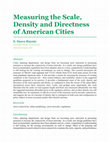
Cities, planning departments, and design firms are becoming more interested in promoting measures... more Cities, planning departments, and design firms are becoming more interested in promoting measures to increase the connectivity of street networks. As a result, new design guidelines have been recommended, regulations have been adopted, and yet, a clear, comprehensive understanding is still lacking for the existing environments we seek to change. This research documents the measures of 584,561 road segments and 173,511 blocks from 4,321 local areas across 24 of the most populated American cities. It also provides a means for assessing the measures of existing conditions in the American city – their central tendency and variability, relative to the suggested guidelines proposed in for practice. It provides a fundamental sense of the scale, density and directness of the road segments and blocks, as configured to form the texture of the urban fabric encountered across these American cities. Lastly, and perhaps more importantly, this work illustrates that the scales of road segment lengt...
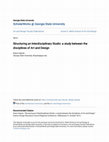
Many Interior Design programs emphasize an interdisciplinary approach among traditional disciplin... more Many Interior Design programs emphasize an interdisciplinary approach among traditional disciplines of design. They utilize both community and business partners to provide realworld opportunities for students. Often these design challenges integrate the practice of interior design with other construction industries; but more recently, developers are integrating art, and its associated programming, into their projects. Art as a discipline is distinct from Design; thus structuring a studio environment that facilitates greater exchange and communication should be studied. This past year, six students from different disciplines – interior design, graphic design, and photography, came together for a unique studio. They were asked to conceptualize, develop, budget, and construct an exhibit for a local developer. The student’s design challenge was to create an exhibit that not only described the building’s historical significance and the developer’s marketing efforts for re-branding/reposi...
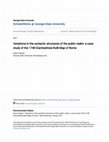
Often, those studying syntactic structures have focused either on the traditional notion of the p... more Often, those studying syntactic structures have focused either on the traditional notion of the public realm – the space most commonly described as the street, or the private realm – defined often as simply the area within the building interior. Few have investigated if or how the intelligible structure of the city is shifted when these two realms are considered concurrently. Does the inclusion of publicly accessible, interior space as part of the traditional urban syntactic analysis affect the resulting intelligible structure of the city? With Nolli’s 1748 plan of Rome as a case study, the densest, most central section of the map is used to create a comparative analysis to explore this central question. First, a syntactic analysis is constructed from the traditional definition of the city as the street structure; it is subsequently analyzed; and the core cognitive structure is extracted. As a comparison, the syntactic analysis is reconstructed with the inclusion of Nolli’s interior...
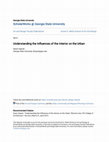
Theory: Politically, Arendt (1958) has described the public realm as that which appears to all of... more Theory: Politically, Arendt (1958) has described the public realm as that which appears to all of us, is common to all of us, and yet is distinguished from the privately owned; while, others suggest that we should consider the public realm not only as all that is politically defined as public, but all that effectively functions as public as well (Hajer and Reijndorp 2001; Kayden 2000). So the question arises, how are the structures of public space, in reality, affected and/or shifted when access to perceived public space is considered as part of the public realm? Framework: Using a section of the 1748 Giambattista Nolli map of Rome, a vector map is constructed first to represent the central path of circulation through the politically defined public realm; and then second to illustrate the central path of circulation through the perceived public realm. An analytical analysis, using Spatialist_lines, is run on the two vector maps, and the measures of metric reach and directional reach...
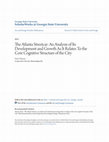
As shown previously by the work of Haynie & Peponis at the 7 Space Syntax Symposium in 2009, the ... more As shown previously by the work of Haynie & Peponis at the 7 Space Syntax Symposium in 2009, the spatial structure of the city of Atlanta has shifted significantly as the city grew. It emerged from a pattern of colliding grids, which bridged the railroads, and an analysis of these early maps illustrated a centrally located area of dense street connectivity distinct from the spaces that are more easily accessible in terms of direction changes – where direction changes describe cognitive rather than metric accessibility. As the city grew and additional clusters of higher local density emerged, each isolated from the other, a multi-centered city was established with ever increasing fragmentation of the Directional Reach structure. Eventually then, the city is forced to negotiate the dispersed pattern of cognitive integration and metric density through a symbolically, culturally supported patchwork of dispersed areas of interest. In this paper, the evolution of the Atlanta Streetcar, si...
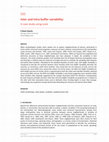
Many morphological studies select sample sets to explore neighbourhoods of interest, particularly... more Many morphological studies select sample sets to explore neighbourhoods of interest, particularly in terms of their structural street properties, measures of scale or density, and proximity to the metropolitan center (Cervero and Gorham, 1995, Crane and Crepeau, 1998, French and Scoppa, 2007, Handy et al., 2003, Jacobs, 1993, Peponis et al., 2007, Southworth and Owens, 1993); yet beyond the established and distinctive structures of these neighborhoods, few have analyzed, in depth, the variability in their measures. This study randomly samples 4,321 localities from the 24 largest American metropolitan areas and describes a method using the measures of length and area to evaluate the variability both between and within these localities. Calculated as the standard deviation of mean scale, Inter Buffer Variability is introduced to describe the variation between these localities while Intra Buffer Variability describes the variation, or consistency, within these localities. How varied th...
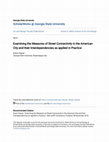
Street patterns, and their measures of connectivity, are significant factors in urban planning an... more Street patterns, and their measures of connectivity, are significant factors in urban planning and design, as illustrated by the APA’s Planning and Urban Design Standards (Handy, Paterson, & Butler, 2003). Studies have looked at the measures of dense urban areas, sparse suburban areas, and in most cases, contrasted the two to characterize differences in planning history, patterns of growth, and associated impacts. Strong correlations have been demonstrated between the measures of street connectivity, and yet despite these trends, further examination demonstrates that not all measures capture the same level of connectivity. The importance of these measures, particularly as they are introduced into regulatory frameworks, indicates a need for an extensive study of their interdependencies. This research illustrates clearly the inconsistencies between the measures of street connectivity, examines how the measures covary for networks with distinct morphologies, and presents an argument fo...

# 67 MORPHOLOGICAL CHARACTERISTICS OF THE AMERICAN CITY A case study benchmarking measures of street connectivity
Many studies have looked at the measures of existing street networks, analysing dense, traditiona... more Many studies have looked at the measures of existing street networks, analysing dense, traditional urban areas and sparse, suburban areas. In most cases, these studies contrast the two extremes to describe both quantitative and qualitative differences. Cervero and Gorham (1995) analysed the scale of road segments to distinguish automobile versus transit-oriented neighbourhoods. Siksna (1997) examined block size and its effects on urban development. Hillier (1999) analysed the intelligibility and connectivity of several city centres to describe the local principles of city growth and their impacts on sustaining strength and vitality. Jacobs (1993), Major (2015), and Peponis, Allen, Haynie, et al. (2007) illustrated significant differences in the scales and densities of various neighbourhoods of historical influence. Few have looked at the American city comprehensively and tried to adequately depict its more common morphological characteristics. In response, this work establishes a de...
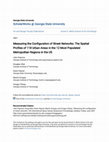
In this paper we report an analysis of 118 urban areas sampled from the 12 largest metropolitan r... more In this paper we report an analysis of 118 urban areas sampled from the 12 largest metropolitan regions in the US. We deal with familiar measures of block size, street density, intersection density and distance between intersections. We also introduce two new variables, Reach and Directional Distance. Reach is the aggregate street length that can be accessed from the midpoint of each road segment subject to a limitation of distance. Directional distance is the average number of direction changes needed in order to access all the spaces within reach. We provide parametric definitions of these variables and implement their computation using new software which runs on standard GIS representations of street center lines. Building Large Comparative Data Bases of Street Configuration to Assist Urban Design and Planning If we were able to analyze the existing GIS representations of street networks, a comparative study in the structure of connectivity of cities could be accelerated. To allo...
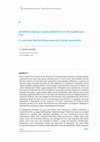
Many studies have looked at the measures of existing street networks, analysing dense, traditiona... more Many studies have looked at the measures of existing street networks, analysing dense, traditional urban areas and sparse, suburban areas. In most cases, these studies contrast the two extremes to describe both quantitative and qualitative differences. analysed the scale of road segments to distinguish automobile versus transit-oriented neighbourhoods. Siksna (1997) examined block size and its effects on urban development. Hillier (1999) analysed the intelligibility and connectivity of several city centres to describe the local principles of city growth and their impacts on sustaining strength and vitality. Jacobs (1993), Major , and Peponis, illustrated significant differences in the scales and densities of various neighbourhoods of historical influence. Few have looked at the American city comprehensively and tried to adequately depict its more common morphological characteristics. In response, this work establishes a description of the measures of street connectivity for existing street networks, as they occur across the American city, and creates a comparative database to describe the multitude of urban morphologies encountered.
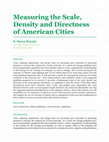
Cities, planning departments, and design firms are becoming more interested in promoting measures... more Cities, planning departments, and design firms are becoming more interested in promoting measures to increase the connectivity of street networks. As a result, new design guidelines have been recommended, regulations have been adopted, and yet, a clear, comprehensive understanding is still lacking for the existing environments we seek to change. This research documents the measures of 584,561 road segments and 173,511 blocks from 4,321 local areas across 24 of the most populated American cities. It also provides a means for assessing the measures of existing conditions in the American city – their central tendency and variability, relative to the suggested guidelines proposed in for practice. It provides a fundamental sense of the scale, density and directness of the road segments and blocks, as configured to form the texture of the urban fabric encountered across these American cities. Lastly, and perhaps more importantly, this work illustrates that the scales of road segment length and block area measured substantially less than the suggested maximum allowable given in the regulatory policies, and yet their density was still remarkably low. In conclusion, it calls for a review of the measures used to describe connectivity, and suggests the use of a measure of density that is contingent on both scale and configuration to policy makers to more accurately predict their desired outcome.
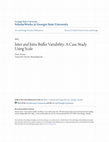
Many morphological studies select sample sets to explore neighbourhoods of interest, particularly... more Many morphological studies select sample sets to explore neighbourhoods of interest, particularly in terms of their structural street properties, measures of scale or density, and proximity to the metropolitan center (yet beyond the established and distinctive structures of these neighborhoods, few have analyzed, in depth, the variability in their measures. This study randomly samples 4,321 localities from the 24 largest American metropolitan areas and describes a method using the measures of length and area to evaluate the variability both between and within these localities. Calculated as the standard deviation of mean scale, Inter Buffer Variability is introduced to describe the variation between these localities while Intra Buffer Variability describes the variation, or consistency, within these localities. How varied then are the measures of scale, and are the measures for some MSAs more varied than others? As will be shown, the MSA Inter Buffer Variability for both length and area are broad, which is expected given both the urban and suburban localities captured across each MSA; and yet, the MSA Intra Buffer Variability is also broad suggesting more variation within these localities than originally suggested by the samples illustrated within the literature. Comparatively for each measure of length and area, both Inter and Intra Buffer Variability are graphed one in relation to the other with their associated means used to delineate those trending higher or lower than average. Interestingly, four quadrants emerge distinctively delineating the measures of scale for these MSAs.
6th International Space Syntax Symposium, 2007
In this paper we report an analysis of 118 urban areas sampled from the 12 largest metropolitan r... more In this paper we report an analysis of 118 urban areas sampled from the 12 largest metropolitan regions in the US. We deal with familiar measures of block size, street density, intersection density and distance between intersections. We also introduce two new variables, Reach and Directional Distance. Reach is the aggregate street length that can be accessed from the midpoint of each road segment subject to a limitation of distance. Directional distance is the average number of direction changes needed in order to ...
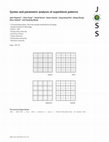
A particular kind of street network is examined, where strong differentiation between scales of s... more A particular kind of street network is examined, where strong differentiation between scales of syntactic structure is evident: supergrids of primary roads, with inserted local streets. Computational formulae are provided to describe simple regular systems and clarify the nature of the syntactic differentiation of scales. The focus is on the linear extension of streets and also on distances measured according to direction changes. A small sample of examples from Chicago, Los Angeles, Beijing and Seoul as well as the Doxiadis plan for sector G7 of Islamabad and the Perry-Whitten neighborhood plan for New York are also analyzed, leading to estimates of a number of remarkably consistent parameters that can function as benchmarks for design exploration or theoretical experimentation. An experiment whereby the fabric of the historic centers of small French towns is inserted into a supergrid at 0.5 mile intervals is also described to explore the scale and character of inserted systems in comparison to historic urban fabrics. The work leads to a methodological proposition. Supergrids can best be conceptualized by decomposing the analysis of closeness centrality (integration) into two components: the mean directional distances associated with the supergrid as an independent system, and the mean directional distances from inserted streets to the nearest supergrid element (step depth in DepthMap). Decomposition responds to a theoretical idea: cognitive maps comprise a skeleton system relative to which other parts can be ‘placed’ and related. Decomposition also responds to a practical purpose: in order to design one must work with intuitively accessible parameters that can be controlled within the site and scope of the design.
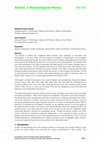
The evolution of Atlanta has undergone distinct phases, each seemingly in association with transp... more The evolution of Atlanta has undergone distinct phases, each seemingly in association with transportation. In the early 1840s, the city emerged as a pattern of colliding grids coming together around three intersecting railroads. By the late 1890s, the first curvilinear street patterns were introduced in the early suburbs along with the street car as an early form of mass transportation. The increase in the use of the automobile in the 1920s is associated with faster growth in the suburbs, although many of them were still curvilinear. The first interstates were built in the 1950s and pushed urban expansion to a much wider radius around the old historic city center of Atlanta. In the 1960s, cul-de-sacs and residential enclaves became the dominant mode of growth and remain so. And throughout this evolution, the size of urban blocks has tended to increase, while spatial integration has tended to decrease, shown by Peponis, Allen, Haynie et al. in an earlier paper presented at the 6SSS of 2007.
Presentations by S. Dawn Haynie
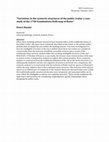
Often, those studying syntactic structures have focused either on the traditional notion of the p... more Often, those studying syntactic structures have focused either on the traditional notion of the public realm – the space most commonly described as the street, or the private realm – defined often as simply the area within the building interior. Few have investigated if or how the intelligible structure of the city is shifted when these two realms are considered concurrently. Does the inclusion of publicly accessible, interior space as part of the traditional urban syntactic analysis affect the resulting intelligible structure of the city? With Nolli's 1748 plan of Rome as a case study, the densest, most central section of the map is used to create a comparative analysis to explore this central question. First, a syntactic analysis is constructed from the traditional definition of the city as the street structure; it is subsequently analyzed; and the core cognitive structure is extracted. As a comparison, the syntactic analysis is reconstructed with the inclusion of Nolli's interior spaces, as illustrated within the map, added to that of the traditional street structure. The inclusion of the interior spaces as an added layer of complexity in the analysis illustrates that particular areas within the traditionally public structure do become more integrated, and associated shifts can be seen within the intelligible as well as core cognitive structure. These results emphasize the importance and necessity for considering comprehensive spatial relationships when designing the public realm.
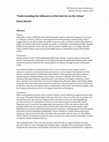
Theory: Politically, Arendt (1958) has described the public realm as that which appears to all of... more Theory: Politically, Arendt (1958) has described the public realm as that which appears to all of us, is common to all of us, and yet is distinguished from the privately owned; while, others suggest that we should consider the public realm not only as all that is politically defined as public, but all that effectively functions as public as well (Hajer and Reijndorp 2001; Kayden 2000). So the question arises, how are the structures of public space, in reality, affected and/or shifted when access to perceived public space is considered as part of the public realm? Framework: Using a section of the 1748 Giambattista Nolli map of Rome, a vector map is constructed first to represent the central path of circulation through the politically defined public realm; and then second to illustrate the central path of circulation through the perceived public realm. An analytical analysis, using Spatialist_lines, is run on the two vector maps, and the measures of metric reach and directional reach are used to explore the influences of the interior on that which is traditionally urban. Metric reach measures the linear distance captured given a limited distance and is thus a measure of density. Directional reach measures the linear distance captured given a set number of changes in direction, and is thus a measure of connectivity in terms of configuration (Peponis, Bafna, and Zhang 2008). Given the size of the Nolli map selected for study here, the parameter for metric reach is set at 660 feet; and then directional reach is analyzed for both 0 and 2 directional changes, with the change in direction set first at 10 degrees and then at 30 degrees. Conclusions: When reviewing the analysis, first in terms of metric reach, differences appear between the two maps. The path with the highest density shifts from one area of the city to another. For directional reach, the structure remains fairly consistent, with each map highlighting portions of Sixtus V's axial plan for Rome; yet, the map of the perceived public realm illustrates more clearly the emerging spine and structure of the city that we know and navigate. When the two measures are overlaid, the map of the perceived public realm demonstrates a greater intersection between the measures, overlapping the areas of density with those of local and global intelligibility. These variables, or those measuring similar attributes, when intersected often coincide with successful, vibrant areas of a city (Hillier 1996). Clearly, the inclusion of interior space as part of an urban analysis illustrates a better conceptual understanding of the city. The traditional idea of the city and its street structure fails to capture all that we truly perceive when we move through and navigate space. Arguably then, practitioners should recognize the importance and perhaps necessity for considering comprehensive, congruent

Uploads
Papers by S. Dawn Haynie
Presentations by S. Dawn Haynie